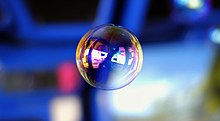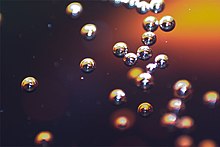Bubble (physics)


Abubbleis aglobuleof agassubstance in a liquid. In the opposite case, a globule of a liquid in a gas, is called adrop.[1] Due to theMarangoni effect,bubbles may remain intact when they reach the surface of the immersive substance.
Common examples
[edit]Bubbles are seen in many places in everyday life, for example:
- As spontaneousnucleationof supersaturatedcarbon dioxideinsoft drinks
- Asvaporin boiling water
- Asairmixed into agitated water, such as below a waterfall
- Assea foam
- As asoap bubble
- As given off in chemical reactions, e.g., baking soda + vinegar
- As a gas trapped inglassduring its manufacture
- As the indicator in aspirit level
- Asbubble gum
Physics and chemistry
[edit]Bubbles form and coalesce into globular shapes because those shapes are at a lower energy state. For the physics and chemistry behind it, seenucleation.
Appearance
[edit]
Bubbles are visible because they have a differentrefractive index(RI) than the surrounding substance. For example, the RI of air is approximately 1.0003 and the RI of water is approximately 1.333.Snell's Lawdescribes how electromagnetic waves change direction at the interface between two mediums with different RI; thus bubbles can be identified from the accompanyingrefractionandinternal reflectioneven though both the immersed and immersing mediums are transparent.
The above explanation only holds for bubbles of one medium submerged in another medium (e.g. bubbles of gas in a soft drink); the volume of amembrane bubble(e.g. soap bubble) will not distort light very much, and one can only see a membrane bubble due tothin-film diffractionandreflection.
Applications
[edit]Nucleation can be intentionally induced, for example, to create abubblegramin a solid.
In medicalultrasoundimaging, small encapsulated bubbles calledcontrast agentare used to enhance the contrast.
In thermalinkjetprinting, vapor bubbles are used as actuators. They are occasionally used in othermicrofluidicsapplications as actuators.[2]
The violent collapse of bubbles (cavitation) near solid surfaces and the resulting impinging jet constitute the mechanism used inultrasonic cleaning.The same effect, but on a larger scale, is used in focused energy weapons such as thebazookaand thetorpedo.Pistol shrimpalso uses a collapsing cavitation bubble as a weapon. The same effect is used to treatkidney stonesin alithotripter.Marine mammals such asdolphinsandwhalesuse bubbles for entertainment or as hunting tools.Aeratorscause the dissolution of gas in the liquid by injecting bubbles.
Bubbles are used bychemicalandmetallurgicengineerin processes such as distillation, absorption, flotation and spray drying. The complex processes involved often require consideration for mass and heat transfer and are modeled usingfluid dynamics.[3]
Thestar-nosed moleand theAmerican water shrewcan smell underwater by rapidly breathing through their nostrils and creating a bubble.[4]
Research onthe origin of life on Earthsuggests that bubbles may have played an integral role in confining and concentratingprecursor moleculesfor life, a function currently performed bycell membranes.[5]
Bubble lasersuse bubbles as the optical resonator. They can be used as highly sensitive pressure sensors.[6]
Pulsation
[edit]When bubbles are disturbed (for example when a gas bubble is injected underwater), the wall oscillates. Although it is often visually masked by much larger deformations in shape, a component of the oscillation changes the bubble volume (i.e. it is pulsation) which, in the absence of an externally-imposed sound field, occurs at the bubble'snatural frequency.The pulsation is the most important component of the oscillation, acoustically, because by changing the gas volume, it changes its pressure, and leads to the emission of sound at the bubble's natural frequency. For air bubbles in water, large bubbles (negligiblesurface tensionandthermal conductivity) undergoadiabaticpulsations, which means that no heat is transferred either from the liquid to the gas or vice versa. The natural frequency of such bubbles is determined by the equation:[7][8]
where:
- is thespecific heat ratioof the gas
- is thesteady stateradius
- is the steady statepressure
- is themassdensityof the surrounding liquid
For air bubbles in water, smaller bubbles undergoisothermalpulsations. The corresponding equation for small bubbles of surface tension σ (and negligible liquidviscosity) is[8]
Excited bubbles trapped underwater are the major source of liquidsounds,such as inside our knuckles during knuckle cracking,[9]and when araindropletimpacts a surface of water.[10][11]
Physiology and medicine
[edit]Injury by bubble formation and growth in body tissues is the mechanism ofdecompression sickness,which occurs when supersaturated dissolved inert gases leave the solution as bubbles duringdecompression.The damage can be due to mechanical deformation of tissues due to bubble growth in situ, or by blockingblood vesselswhere the bubble has lodged.
Arterial gas embolismcan occur when a gas bubble is introduced to the circulatory system and lodges in a blood vessel that is too small for it to pass through under the available pressure difference. This can occur as a result ofdecompressionafter hyperbaric exposure, alung overexpansion injury,duringintravenous fluid administration,or duringsurgery.
See also
[edit]- Antibubble
- Bubble fusion
- Bubble sensor
- Foam
- Minnaert resonance
- Nanobubble
- Sonoluminescence
- Underwater acoustics
References
[edit]- ^Subramanian, R. Shankar; Balasubramaniam, R. (2001-04-09).The Motion of Bubbles and Drops in Reduced Gravity.Cambridge University Press.ISBN9780521496056.
- ^R. J. Dijkink, J. P. van der Dennen, C. D. Ohl,A. Prosperetti,The ‘acoustic scallop’: a bubble-powered actuator,J. Micromech. Microeng.161653 (2006)
- ^Weber; et al. (1978).Bubbles, Drops and Particles.New York: Dover Publications.ISBN978-0-486-44580-9.
- ^Roxanne Khamsi."Star-nosed mole can sniff underwater, videos reveal".
- ^Whitcomb, Isobel (August 6, 2019)."The Key to Life's Emergence? Bubbles, New Study Argues".LiveScience.RetrievedJanuary 8,2022.
- ^Miller, Johanna."Bubble lasers can be sturdy and sensitive".Physics Today.American Institute of Physics.Retrieved2 April2024.
- ^Minnaert, Marcel, On musical air-bubbles and the sounds of running water, Phil. Mag. 16, 235-248 (1933).
- ^abLeighton, Timothy G., The Acoustic Bubble (Academic, London, 1994).
- ^Chandran Suja, V.; Barakat, A. I. (2018-03-29)."A Mathematical Model for the Sounds Produced by Knuckle Cracking".Scientific Reports.8(1): 4600.Bibcode:2018NatSR...8.4600C.doi:10.1038/s41598-018-22664-4.ISSN2045-2322.PMC5876406.PMID29599511.
- ^Prosperetti, Andrea; Oguz, Hasan N. (1993). "The impact of drops on liquid surfaces and the underwater noise of rain".Annual Review of Fluid Mechanics.25:577–602.Bibcode:1993AnRFM..25..577P.doi:10.1146/annurev.fl.25.010193.003045.
- ^Rankin, Ryan C. (June 2005)."Bubble Resonance".The Physics of Bubbles, Antibubbles, and all That.Retrieved2006-12-09.






